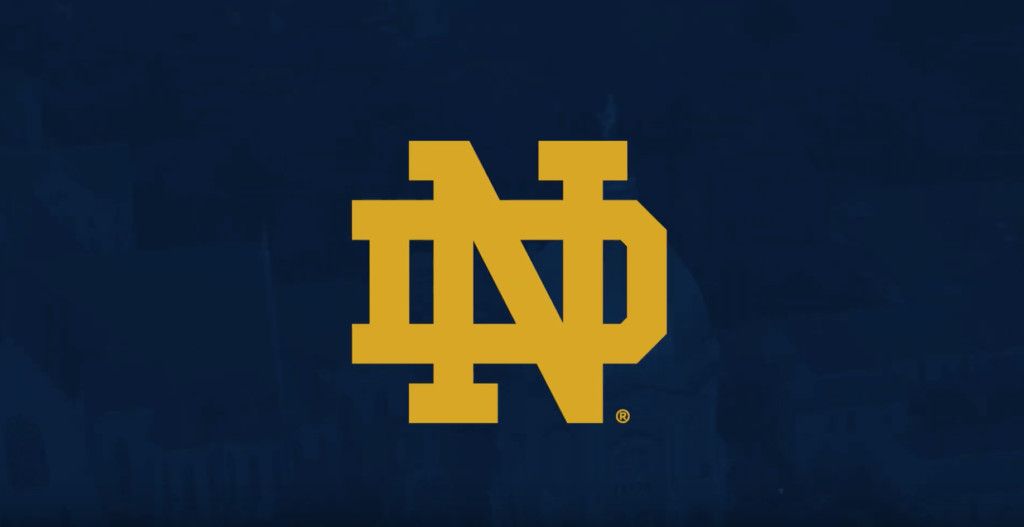Feb. 14, 2003
When Paul Mainieri inherited an emerging national baseball power in the fall of 1994, his infectious sprit and love for the game could not hold him back. He dared to dream big about the goals of the Notre Dame program and set out to prove to the college baseball world that a northern school could compete regularly on a national scale.
Nearly a decade later, as the Irish embark on the ninth season of the Mainieri era, the Notre Dame baseball program truly has made a name for itself. A regular contender for the BIG EAST Conference title and an NCAA tournament participant three times in Mainieri’s first six seasons, the Irish took things to another level in 2001 (earning the program’s first No. 1 national ranking en route to a 49-win season) before continuing to climb in 2002, when the postseason celebrations included winning a Super-Regional series at top-ranked Florida State that sent Notre Dame to the College World Series for the first time since 1957.
And with Mainieri holding the bar that sets the standards for the program, don’t expect the Irish to stop fighting for more high-level success in 2003, with the squad returning the bulk of the pitching staff that finished 13th in the nation for team ERA (3.57) while four of nine position starters return from the clutch-hitting 2002 offense.
“A lot of attention has come to this program in the past few years but there always is more to strive for and the players have a great sense of pride for this program,” says Mainieri, whose last two teams totaled the nation’s third-highest victory total (99) over the span of the 2001 and ’02 seasons.
“There also is a great responsibility in which the current players represent all the former players who have worn that Irish uniform. And they will always represent this program with class and dignity.”
Mainieri and his team also realize that several hurdles must be cleared in order to maintain such a high-bar standard.
“It’s important for our players to understand that this season does not start where last season ended,” he says. “We need to retake those steps that it takes to be successful, qualify for the BIG EAST Tournament and win it again, and then keep building on each success for another great season.”
Notre Dame’s top returning position players include senior rightfielder Kris Billmaier and three members of the junior class: first baseman Joe Thaman, second baseman Steve Sollmann and first-year catcher Javi Sanchez (who filled in as the starting shortstop in 2002).
The five departed starters (all lefthanded hitters) include leftfielder Brian Stavisky (who signed after his junior season, as the sixth-round pick of the Oakland A’s) and four players who formed the core of the 2002 senior class: All-America centerfielder Steve Stanley, third baseman Andrew Bushey, catcher Paul O’Toole and designated hitter Matt Box.
Notre Dame’s likely starters on the leftside of the infield are a pair of sophomores – highly-touted shortstop Matt Macri (“Tommy John” reconstructive elbow surgery) and Matt Edwards (broken leg, suffered during an in-game collision) – who both missed the bulk of the 2002 season due to injuries.
Sollmann and Macri are expected to comprise one of the nation’s premier middle-infield tandems, with Sollmann garnering preseason BIG EAST player-of-the-year honors from the BIG EAST coaches and the National College Baseball Writers of America (who also named him to its preseason All-America team) while Baseball America tabbed Macri as a preseason All-American and the probable BIG EAST player of the year.
A group of five freshmen are expected to be top contenders for the other three open spots in the lineup, with Craig Cooper the likely starter in center field while Cody Rizzo and lefthanded-hitting Brennan Grogan are the top options in left. Infield prospect Greg Lopez and surprising walk-on Steve Andres (a leftside hitter) are the top candidates to fill the DH role.
Senior J.P. Gagne – who joins Billmaier and Sollmann as captains of the 2003 team – returns to lead the pitching staff, after filling a variety of roles from 2000-02 (he was the closer for the second half of the ’02 campaign). Sophomores Grant Johnson and Chris Niesel were being touted as one of the nation’s top young pitching tandems before Johnson underwent season-ending shoulder surgery.
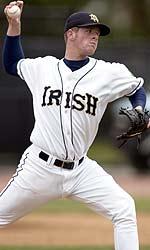
Ryan Kalita
|
Plenty of pitchers are ready to step up to the challenge as possible members of the 2003 rotation, led by seniors Peter Ogilvie and Ryan Kalita. Others include sophomores John Axford and Martin Vergara and a pair of lofty freshmen – 7-foot-1 righthander Ryan Doherty and 6-6 lefty Tom Thornton.
Even with the loss of Johnson, the Irish still return 11 pitchers who combined for 54 starts, 39 wins, 14 saves and 358 strikeouts while logging 449 innings during the 2002 season.
“This pitching staff has several veterans who have proven that they can pitch in the toughest of situations,” says Mainieri. “It makes for a very healthy competition as they push each other to be their best and there’s no reason to think we won’t continue to be one of the top pitching staffs in the nation.”
Notre Dame’s historic 2002 season had many sidenotes, notably the compelling story at shortstop – where the promising freshman duo of Macri and Edwards both were sidelined with early-season injuries. Sanchez (a high school second baseman) stepped into the challenge of a new position and personified the fighting spirit of the 2002 squad. In many ways, the challenges remain the same in 2003.
“Javi is a great story, both for what he did last year and with his switch to catcher this season,” says Mainieri. “But that has been the tradition of this program and is a source of great pride. There always are players who step up to meet any challenges that may come our way. It’s going to be exciting to see how this season unfolds.”
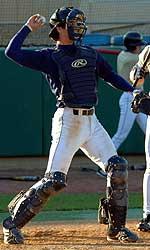
Javi Sanchez
|
Notre Dame’s rightside infielders rate as one of the nation’s top defensive tandems, with both Thaman and Sollmann cited by Baseball America as the BIG EAST’s best defensive players at their respective positions.
Thaman (St. Louis, Mo.) has been a defensive force throughout his career, due to agile footwork, quick reactions and a 6-4, 215-pound frame that provides a big throwing target. A streaky hitter who heads into 2003 with a .278 career batting average, Thaman’s value will be magnified due to the fact that he’s the only returning lefthanded hitter from the six who formed the bulk of the 2002 starting lineup.
“This is a big year for Joe to raise his game, especially because we’ve become a predominantly righthanded-hitting team,” says Mainieri, who watched Thaman hit four of his eight career home runs (including two grand slams) in a six-game lateseason stretch in 2002.
“Joe has a good swing and we’ve seen flashes of how he can impact games – now we need him to be a consistent run producer.”
Several players could back up Thaman at first, ranging from veterans such as Sanchez and Edwards to newcomers Rizzo, Andres or Matt Bransfield. “We always will rely on the philosophy of putting the nine best players on the field, regardless of position, so there are a number of guys who could end up playing some first base this season,” says Mainieri.
Sollmann (Cincinnati, Ohio) – who earned preseason All-America honors and also is an Academic All-America candidate, with a 3.26 GPA as a marketing major – heads into his third campaign simply looking to enjoy a fully-healthy season while maintaining the status quo.
“Steve will continue to be a great player if he stays within himself and does the things that have made him a great player,” says Mainieri, who also coached Sollmann’s brother, centerfielder Scott Sollmann, in 1995 and ’96.
“Our offense lost five starters but Steve can’t try to do too much – other players have responsibility for filling those gaps. He just needs to keep using the whole field while utilizing his bunting, the hit-and-run and stealing bases. He needs to keep being that unsung hero who steps forward at key times. If he keeps doing that, we’ll be in great shape.”
Sollmann fittingly posted identical .362 batting averages in 2001 and ’02, when he was slowed by a nagging quad injury. The 2003 team’s only non-senior captain has taken an active leadership role during his junior season while making an impact on teammates due to his winning personae.
“You really can see Steve’s leadership and experience when he is counseling the younger players and helping them learn the game,” says Mainieri. “Steve also epitomizes our program with his aura as a winner. The bigger the game and the tougher the opponent, the better he plays.”
Sollmann’s compact, level swing yielded a .561 batting average during the 2002 NCAAs while his burgeoning skills at second base (he was a centerfielder in high school) included just eight errors as a sophomore, when he helped the Irish turn a team-record 66 double plays.
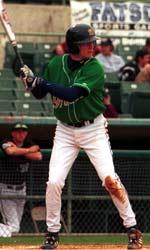
Matt Macri
|
Notre Dame baseball fans – in addition to the team’s players and coaches – will be eager to see the debut of Macri (Clive, Iowa) at his natural position. The two-sport star was the Iowa player of the year in football (as a quarterback) and baseball, after leading Dowling High School to the state title in both sports. A draft-eligible sophomore (he turns 21 before the 2003 MLB draft), Macri has progressed ahead of schedule in his rehabilitation and remains a highly-rated talent, with Baseball America listing him as the nation’s nation’s No. 40 overall prospect for the 2003 draft (he’s the second shortstop on that list, behind Team USA member Aaron Hill of LSU).
“Matt’s production will play a large part in our success,” says Mainieri. “We’re counting on him being our 3-hole hitter and everyday shortstop. If he plays to his capabilities, we’re going to have another great year.”
Macri’s widespread skills include tremendous bat speed and power to all fields to go along with excellent range, good hands and a powerful arm – plus classic baseball instincts, with the agility to make high-level plays. But Mainieri has been impressed with another dimension.
“Most kids would ask ‘Why me’s’ but it’s amazing how Matt handled the situation,” says Mainieri, who was thrilled to see his star shortstop participating in the NCAA Regional dogpile and traveling on his own to support his teammates at the CWS.
Macri’s 2002 stats in limited DH action included a .206 batting average in 68 at-bats, with 13 RBI and one home run. “Forget about those numbers, that’s an aberration,” says Mainieri. “Matt needs to know that the team’s success is in large part due to his efforts. When you take that away, it affects his whole psyche of how he plays.”
Another inspiring comeback story is slated to unfold to Macri’s right, with Edwards (Mechanicsville, Va.) on track to return from his broken leg suffered during the ninth game of 2002. Known for clutch hitting and good hands in the field, Edwards was hitting a solid .290 at the time of his injury.
“Matt played third base in his senior year of high school and is a kid who won’t get cheated at the plate – we really expect him to drive in a lot of runs in the middle of the order,” says Mainieri. “He showed tremendous character in the face of adversity and it will pay off in the long run.”
Lopez (Upper Arlington, Ohio) could be the team’s top utility infielder, after a stellar prep career at shortstop (he was rated by The Buckeye Scout as the best infield prospect to come out of Ohio in the last five years).
“Greg’s a very steady, clutch performer who could remind people of J.J. Brock (’94-’98),” says Mainieri. “He will be a very solid player as he gains experience and could be the future leader of our infield.”
Junior newcomer Tim Murray (Shrub Oak, N.Y.) also could be a top utility infielder, after impressing the coaches with his defensive skills (particularly at shortstop) in fall walk-on tryouts.
Bransfield (Englewood, Colo.) is a versatile addition who could be used at either corner infield spot. A hard-nosed competitor as a third baseman, pitcher and football quarterback at Cherry Creek High School (which also produced former ND pitcher and current Houston Astro Brad Lidge), Bransfield proved to be a dangerous hitter during the 2002 fall season.
Senior first baseman Mike Holba (Lansing, Ill.) and junior infielder Zach Sisko (Belleville, Ill.) will continue to provide depth to the Irish lineup, with the lefthahnded-hitting Sisko serving as a member of the 2002 postseason roster while the 6-8 Holba provides a big target at first base and has provided some key hits during limited play over his first three seasons.
Sanchez (Miami, Fla.) – who has made quick progress behind the plate, under the guidance of assistant coach David Grewe – was a surprise contributor in 2002, when he made some key defensive plays at another new position (shortstop) while also providing clutch hits, all after totaling just 13 at-bats as a freshman.
“Macri’s return allowed us to move Javi to a position of need, that being behind the plate,” says Mainieri of Sanchez, who made just one error in nine 2002 NCAA Tournament games while compiling a 12-game hitting streak.
“Javi has great tools as a catcher, with arm strength, soft hands and good size (6-2, 200). Those skills, combined with his savvy and experience, will allow for a quick adjustment.”
Andres (Napa, Calif.) enters 2003 as the No. 2 catcher and a top option as a lefthanded DH. A pleasant surprise in 2002 fall workouts, Andres was an accomplished baseball player and option quarterback at Justin Siena High School but had to make a courageous return from a broken leg suffered during his junior year (the injury required insertion of a medal rod into his leg).
“Steve has a tremendous lefthanded swing, which fills a void in our lineup, and he could become a very good college hitter,” says Mainieri. “We also like his instincts behind the plate, with soft hands and good blocking ability – he could be a big overall boost for us this season.”
Rizzo (Temecula, Calif.) will look to continue improving on his skills behind the plate while seeing time at several positions (including left field). “Cody was a great baseball and soccer player in high school and that athleticism will be a huge benefit,” says Mainieri. “He’s a great all-around player and clutch hitter, with excellent baserunning and baseball knowledge. Cody will catch a good portion – he has a strong arm and is agile and quick – but he’s also an excellent outfielder and all-in-all will contribute in a big way.”
Freshman Sam Richey (Minneapolis, Minn.) rounds out the catching corps, after earning a roster spot during fall walk-on tryouts.
Notre Dame could boast one of the top defensive outfields in the Mainieri era. Billmaier (Woodinville, Wash.) leads the way as the returner in right field, looking to continue his momentum from 2002, when he hit .615 (16-for-26) in the NCAA Regional and Super-Regional rounds.
“Kris is coming off a great fall and is a player who always has delivered in those clutch NCAA situations – he’s fearless and loves the spotlight,” says Mainieri, whose current team also includes the program’s No. 3 all-time hitter in NCAA Tournament games (Sollmann, at .459).
“Now it’s time for Kris to raise his consistency. He simply will have to be a big-time RBI producer as our likely cleanup hitter.”
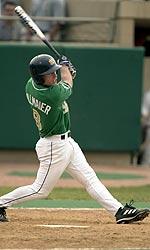
Kris Billmaier
|
Billmaier (who hit .313 overall in ’02, with 41 RBI and three home runs) also has developed into a gifted outfielder, after converting from the infield where he played as a prep.
Cooper (Plainview, N.Y.) has emerged as the top candidate to fill the unfillable shoes of Stanley, who started all 256 games from 1999-2002 (all in center field) while missing just 25 total innings.
“Nobody is capable of being the same type of centerfielder as Steve Stanley, but people will be impressed with what Craig Cooper can do out there,” says Mainieri of the two-time prep Gold Glove award winner and the BIG EAST’s second-best newcomer, according to Baseball America.
“Craig is a very steady, instinctive outfielder with a strong arm. He gets great jumps on the ball and makes the catches he’s supposed to make.”
Cooper also could inherit Stanley’s leadoff spot, with strong all-around skills that he displayed during the 2002 Blue-Gold series (4-for-10, HR, 3B, BB, SB). “Craig has a very consistent righthanded swing and the ball jumps off hit bat. He can drive the gaps and knock some balls out, in addition to being a very good basestealer due to his ability to get good jumps,” says Mainieri.
Grogan (Tequesta, Fla.) is the top option to replace Stavisky in left field, with the righthanded-hitting Rizzo also expected to see time at the position. An accomplished prep centerfielder, Grogan is noted for his unending hustle and strong throwing arm.
“Brennan gives a huge boost to our outfield defense but he also will be one of those key lefthanded batters who will have to deliver timely hits,” says Mainieri. “He has the knack for putting the bat on the ball and finding the holes to get hits. He can hit the long ball but also will use bat control and speed to manufacture runs.”
Freshman Alex Nettey (Dolton, Ill.) also could see time in the outfield, with the potential to develop as he gains college-level experience. Known for a quick bat that can drive the gaps, Nettey showed the ability to quickly adapt to the college game during 2002 fall practice, when he hit well against some of Notre Dame’s top pitchers.
Sophomore Brent Weiss (Cockeysville, Md.) was expected to be in the catcher and outfield mix but was lost for the season after undergoing preseason shoulder surgery. A solidly-built, 6-1, 200-pound power hitter, Weiss was a candidate to replace some of Stavisky’s long-ball threat after showing glimpses of his potential impact with a pair of towering grand slams late in 2002.
The pitching staff again will look for leadership from Gagne (Bloomington, Minn.), who has emerged as one of the true leaders of the Notre Dame baseball program and likely will return to the closer role in 2003, after serving as a weekend starter for his first two-plus seasons.
“J.P. has been through the wars and knows what it took to bring this program to its present level,” says Mainieri of Gagne, who is just the fourth pitcher to serve as a Notre Dame baseball captain in the last 28 years.
“We were able to move J.P. to the bullpen because of his gutsy competitiveness and ability to throw strikes on a consistent basis. Of course, he also was the versatility to pitch in any role. You won’t find many pitchers who are that valuable.”
Gagne endured some rocky moments in the 2002 postseason before playing a lead role in the Super Regional series at Florida State. An Academic All-America candidate with a 3.35 GPA as a finance major, Gagne’s career numbers include a low walk average (2.35 per 9 IP) to go along with a 4.20 ERA, 21-10 record and 160 Ks in 238 innings. His 2002 numbers (3.14, 9-4, 6 saves, 69 Ks, 16 BB in 94.2 IP) included winning seven of his final nine decisions while posting a 3-0 record, 15 Ks and just one walk in 18 postseason innings.
Niesel and Johnson were expected to form one of the nation’s premier 1-2 punches in 2003, after combining in the 2002 postseason for a 2.67 ERA and 5-1 record in 10 appearances (nine starts), plus 41 strikeouts, 18 walks and 47 hits allowed in 54 postseason innings.
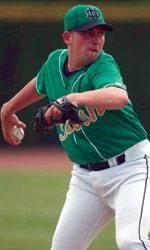
Chris Niesel
|
Niesel (Plantation, Fla.) encountered an interesting journey in 2002, with his final 4-0 record skewed by the fact that he was in line to win several other early-season games before missing five midseason weeks due to mononucleosis. He returned with a vengeance, with his five postseason outings (2.05 ERA, 22 Ks, 7 BB in 26.1 IP) including wins in the clinching games at the NCAA Regional and Super Regional – en route to a 3.36 final season ERA (62 Ks, 18 BB, 68 H in 72.1 IP).
“Chris will be the anchor of our staff and that’s the type of pressure and expectation that he thrives under,” says Mainieri of Niesel, who lived up to selection as one of five first-team high school All-America pitchers in 2001. “Chris has such great command of his pitches and the mental makeup to be an elite pitcher. He’s the type of guy that you look to lead your staff.”
Niesel’s winning tradition sees him heading into 2003 with victories in 22 of his last 23 decisions, including his senior season at Aquinas High School (13-0), the 2002 summer with the Cape Cod League’s Falmouth Commodores (3-1) and wins in the ’01 and ’02 Blue-Gold fall intrasquad series (plus 4-0 with the ’02 Irish). A classic strike thrower with a fastball that can touch the low 90s and the “best breaking ball in the BIG EAST” (per Baseball America), Niesel was projected by Perfect Game/BA as the No. 49 prospect for the 2004 draft (with the Major League Baseball Scouting Bureau’s 2002 fall rankings placing him at the top of their projected 2004 draft list).
Johnson (Burr Ridge, Ill.) – a 2003 preseason All-American who was projected by PG/BA as the No. 7 prospect for the 2004 draft – emerged as a special talent in 2002, earning Freshman All-America honors and a spot on the USA National Team while delivering several top postseason outings (including a 1-hit masterpiece in the 25-1 NCAA Regional win over South Alabama). He set the Notre Dame freshman record for strikeouts (86) and tied the rookie mark for wins (9-5, including seven straight heading into the CWS) to go along with a 3.46 season ERA, just 44 walks and 94 hits allowed in 101 innings.
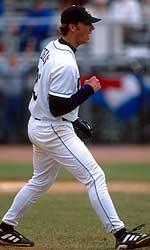
Peter Ogilvie
|
Ogilvie (Buffalo Grove, Ill.) logged some huge complete-game performances during the past two seasons, including 2001 wins over Michigan and Florida International (in the NCAAs) and 2002 victories over BIG EAST challengers Virginia Tech and Boston College (plus a hard-luck, 4-3 loss to Rutgers in the BIG EAST Tournament). After overcoming a three-year battle with injuries that included his freshman season with the Irish (2000), the 6-3, 220-pounder went on to post a 3.56 ERA and 12-6 record in 132 innings spanning the ’01 and ’02 seasons (88 Ks, 37 BB).
“Pete may not blow you away with his stats or a blazing fastball, but he’s a guy that has been very steady while pitching in a lot of big ballgames,” says Mainieri of Ogilvie, who has the option of applying for a fifth year of eligibility.
“He beats teams with that sneaky fastball, good command of his curve and a change of speeds. But he also has become a smarter pitcher because of his big-game experiences. If there’s a battle-tested pitcher, it would be Pete Ogilvie.”
Kalita (Oak Park, Ill.) played a huge role in 2002 (3.16, 5-0, 36 Ks in 42.2 IP), after seeing minimal action his first two seasons. A versatile performer who can attack hitters as a finesse or power pitcher, the brother of former Irish lefthander and current Detroit Tigers prospect Tim Kalita (’96-’99) is expected to contend for a top spot in the 2003 rotation.
“We quite simply would not have had such a great season in 2002 if not for some of those outings from Ryan Kalita,” says Mainieri, in reference to the regular-season duel with Virginia Tech ace lefthander Joe Saunders and Kalita’s gutsy seven innings of shutout relief to deliver the program’s first BIG EAST Tournament title.
“It’s great to see Ryan enjoy this success because he waited his turn and has capitalized on his maturing as a pitcher. He could be a real critical guy for us this season.”
The hard-throwing Axford (Port Dover, Ontario) – who joined the Irish after being selected by the Seattle Mariners in the seventh round of the 2001 draft – could show the greatest improvement on the staff, after totaling the same number of walks (89) and strikeouts (89) during his combined 2002 seasons with Notre Dameand the Cape Cod League’s Hyannis Mets.
“John has the most electric stuff on the staff and possibly in college baseball. It’s just a matter of consistency, in terms of his mechanics, locating three pitches for strikes and staying out of trouble,” says Mainieri of Axford, who actually posted some of the best freshman pitching numbers of the Mainieri era (3.95 ERA, 64 Ks in 70.2 innings) but was overshadowed by Johnson and Niesel’s postseason exploits.
Axford’s high-reaching potential (he’s projected by PG/BA as college baseball’s No. 19 prospect for the 2004 draft) is a result of a fastball that can touch the high-90s and a low 2002 opponent batting average (.231) that was counteracted by his 59 walks, seven wild pitches and six hit batters. A fearless competitor, Axford was Notre Dame’s No. 1 starter for several weeks during the mid-part of the 2002 season, including a strong outing versus Arizona State.
Vergara (Paterson, N.J.) showed flashes of brilliance as a freshman, en route to a solid 3.79 ERA, 5-1 record and 33 Ks in 35.2 innings. Finetuning his mechanics and a boost in overall consistency are considered key factors for Vergara – with his pitch repertoire (including a moving fastball that can touch 90) and excellent defensive skills helping land him at the No. 79 spot on the PG/BA projections for 2004.
Thornton (Middleboro, Mass.) could develop into a top prospect, with the ability to change speeds and throw three pitches for strikes. With a strong, physical frame (6-6, 205) and the skills to beat opponents as a finesse or power pitcher, the promising lefthander could continue the high level of success he enjoyed as a prep, when he posted a 19-4 career record, 1.09 ERA and 4.9 K-to-walk ratio (236/48) in 148 innings.
Doherty (Toms River, N.J.) shows surprising agility for his 7-1, 230-pound frame and is a strike thrower who attacks hitters while looking to maximize his high release point. A candidate for key innings as he continues to gain experience and strength (he packed on 20 pounds in the fall), Doherty will be looking to take his dominance to the next level – after posting a 1.14 ERA and a 4.5 K-to-walk ratio (85/19, in 63 innings) as the 2002 Gatorade player of the year for New Jersey.
Seniors Matt Laird (Bellaire, Texas) and Brandon Viloria (Wailuku, Hawaii) are veteran members of the bullpen who combine with Gagne in giving the staff three different pitchers who have totaled five-plus career saves.
Laird – who gives hitters a different look with his three-quarter arm slot – served as the closer in 2001 (when the Irish surged to the No. 1 national ranking) while pitching in a variety of roles and big-game situations during a career that has included a 3.80 ERA, 10-3 record and five saves in 90 innings (71 Ks).
Viloria serves as one of the team’s emotional leaders but he is all business on the mound, where he also can serve in a number of relief roles. Despite a series of nagging injuries, the program’s first letterwinner from Hawaii has shown excellent control (11 walks, four hit batters and one wild pitch in 60.2 innings) while posting a 2.97 career ERA, 5-2 record, five saves and 31 strikeouts.
Sophomore Tyler Jones (Arlington, Texas) could take on a greater role, after logging nine innings on the deep 2002 staff (4.00, 1-0, SV, 6 Ks, 9 BB, 9 H). Jones – an all-Jayhawk League selection as a member of the Hays (Kan.) Larks in the summer of 2002 – could develop into a strong power pitcher as he maximizes his 6-4, 205-pound frame. The group of six sophomore pitchers also includes 6-4, 160-pound lefthander Scott Bickford (Owings, Md.), who will be looking to continue adding strength and developing his pitches after making six appearances in 2002 (4.35, 1-0, SV, 12 Ks, BB in 10.1 IP).
Junior Cody Wilkins (Hudson, N.C.) and freshman walk-on Matt Arminio (Brentwood, Tenn.) round out the staff as two of four lefthanded pitchers on the 2003 roster.







